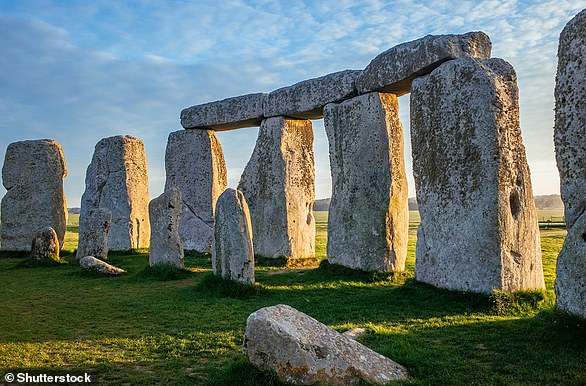Stonehenge is one of Britain’s most prominent prehistoric monuments. The Stonehenge that can be seen today is the final stage that was completed some 3,500 years ago.
According to the monument’s website, Stonehenge was built in four stages:
First stageThe earliest version of Stonehenge was a large earthwork or henge, comprising a ditch, a bank and Aubrey’s holes, all probably built around 3100 BC.
Aubrey holes are round pits in the chalk, about one metre (3.3 ft) wide and deep, with steep sides and flat bottoms.
Stonehenge (pictured) is one of Britain’s most notable prehistoric monuments.
They form a circle about 86.6 metres (284 feet) in diameter.
Excavations revealed cremated human bones in part of the chalk fill, but the holes themselves were probably not made to be used as graves, but as part of a religious ceremony.
After this first stage, Stonehenge was abandoned and left untouched for more than 1,000 years.
Second stageThe second and most spectacular stage of Stonehenge began around 2150 BC, when some 82 bluestones were transported to the site from the Preseli Mountains in south-west Wales. The stones, some of which weigh four tonnes each, are thought to have been dragged on rollers and sledges to the waters at Milford Haven, where they were loaded onto rafts.
They were transported by water along the south coast of Wales and up the rivers Avon and Frome, before being washed ashore again near Warminster and Wiltshire.
The final stage of the journey was mainly by water, down the River Wylye to Salisbury, then up the Salisbury Avon to west of Amesbury.
The journey lasted almost 240 miles and, once at the site, the stones were placed in the center to form an incomplete double circle.
During the same period, the original entrance was enlarged and a pair of Heel Stones were erected. The nearest part of the avenue, connecting Stonehenge to the River Avon, was built aligned with the sunrise of the summer solstice.
Third stageThe third stage of Stonehenge, which took place around 2000 BC, saw the arrival of the sarsen stones (a type of sandstone), which were larger than the bluestones.
They were probably brought from the Marlborough Downs (40 kilometres or 25 miles north of Stonehenge).
The largest sarsen stone transported to Stonehenge weighs 50 tonnes, and would not have been possible to transport by water, so it is suspected that they were transported using sledges and ropes.
Calculations have shown that it would have taken 500 men using leather ropes to pull a stone, and another 100 men to place the rollers in front of the sledge.
These stones were arranged in an outer circle with a continuous row of lintels (horizontal supports).
Inside the circle were placed five trilithons, structures formed by two stones in a vertical position and a third on top as a lintel, in a horseshoe arrangement, which can still be seen today.
Final stageThe fourth and final stage took place just after 1500 BC, when the smaller bluestones were rearranged into the horseshoe and circle that can be seen today.
The original number of stones in the bluestone circle was probably about 60, but they have since been removed or crumbled. Some remain as stumps below ground level.
Fountain: Stonehenge.co.uk


